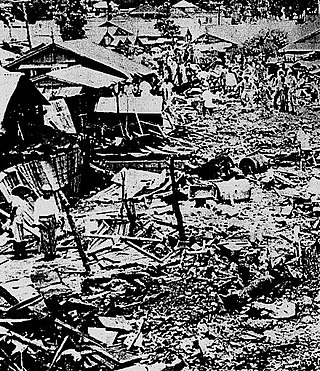
Marine Corps Air Station Iwakuni or MCAS Iwakuni is a joint Japan Maritime Self-Defense Forces and United States Marine Corps air station located in the Nishiki river delta, 1.3 NM southeast of Iwakuni Station in the city of Iwakuni, Yamaguchi Prefecture, Japan.

Marine Corps Air Station Miramar is a United States Marine Corps installation that is home to the 3rd Marine Aircraft Wing, which is the aviation element of the 1st Marine Expeditionary Force. It is located in Miramar, a community of San Diego, California, about 14 miles (23 km) north of downtown San Diego.

Naval Air Facility Atsugi is a joint Japan-US naval air base located in the cities of Yamato and Ayase in Kanagawa, Japan. It is the largest United States Navy (USN) air base in the Pacific Ocean, and once housed the squadrons of Carrier Air Wing Five (CVW-5), which deploys with the American aircraft carrier USS Ronald Reagan.

Blue Impulse is the aerobatic demonstration team of the Japan Air Self-Defense Force (JASDF). The team was founded in 1960 as a team of six F-86 Sabres. They changed mounts to the Mitsubishi T-2 in 1980 and then to the Kawasaki T-4 in 1995. They are based at Matsushima Air Base, which was heavily damaged by the 2011 Tōhoku earthquake and tsunami.

Marine Fighter Attack Training Squadron 501 (VMFAT-501) is a training squadron in the United States Marine Corps, consisting of 27 F-35B Lightning II aircraft and serves as the Fleet Replacement Squadron. Known as the "Warlords," the squadron is based at Marine Corps Air Station Beaufort, South Carolina and falls administratively under Marine Aircraft Group 31 and the 2nd Marine Aircraft Wing. The squadron has assumed the lineage of VMFA-451 which was originally known as the "Blue Devils" and saw action during World War II and Operation Desert Storm. They were decommissioned on 31 January 1997.

The 1988 Remscheid A-10 crash occurred on December 8, 1988, when an A-10 Thunderbolt II attack jet of the United States Air Forces in Europe crashed into a residential area in the city of Remscheid, West Germany. The aircraft crashed into the upper floor of an apartment complex. In addition to the pilot, six people were killed. Fifty others were injured, many of them seriously.

On December 8, 2008, a United States Marine Corps (USMC) F/A-18 Hornet crash in a residential area of San Diego, California. The pilot, First Lieutenant Dan Neubauer (28) from VMFAT-101, was the only crewmember on board the two-seat aircraft; he successfully ejected from the aircraft, landing in a tree. The jet crashed into the University City residential area, destroying two houses and damaging a third. A total of four residents in one house, two adults and two children, were killed.

The 1959 Okinawa F-100 crash, also known as the Miyamori Elementary School crash (宮森小学校米軍機墜落事故), occurred on June 30, 1959, when a North American F-100 Super Sabre of the United States Air Force crashed in Ishikawa, in United States-occupied Okinawa, killing 18 people.

The 1977 Yokohama F-4 crash occurred on 27 September 1977, in Yokohama, Japan. In the crash, a United States Marine Corps (USMC) McDonnell Douglas RF-4B-41-MC, BuNo 157344, c/n 3717, 'RF611' of VMFP-3 flown by a USMC crew based at nearby Naval Air Facility Atsugi, en route to USS Midway in Sagami Bay, suffered a mechanical malfunction, the port engine caught fire, and crashed into a residential neighborhood. The crash killed two boys, ages 1 and 3, and injured seven others, several seriously. The two-man crew of the aircraft, Capt. J. E. Miller, of Mendota, Illinois, and 1st Lt. D. R. Durbin, of Natchitoches, Louisiana, ejected and were not seriously injured.

On 19 November 1968, a B-52 crashed at Kadena Air Base, on the island of Okinawa, Japan.
The list of Aviation Accidents in Japan Involving U.S. Military and Government Aircraft Post-World War II provides a non-exhaustive list of incidents that occurred following Japan's defeat in World War II, when the United States established a substantial military presence with various air bases in Japan. The operations of U.S. military and government aircraft, including those by agencies such as the CIA, led to several aviation accidents, often caused by mechanical failures, pilot errors, and challenging flying conditions. These events significantly affected U.S.-Japan relations, military policies, and safety protocols.










